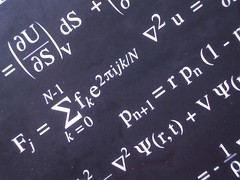I don’t claim this to be new, the earliest reference I can find is Baez and Bunn [1], though I am sure the idea is older than that. The claim is that there is a kind of duality in the Einstein field equations between the Ricci tensor and the energy-momentum tensor. That is one can in essence switch the roles of the Ricci tensor and the energy-momentum tensor in the field equations. I will assume familiarity with the tensors and the field equations.
Lets see how this works. Recall the Einstein field equations in 4d
\(R_{\mu \nu}{-} \frac{1}{2}g_{\mu \nu}R + g_{\mu \nu} \Lambda = \kappa T_{\mu \nu} \),
here \(\kappa = \frac{8 \pi \: G}{c^{4}}\) is the gravitational constant
and of course \(R:= R_{\lambda}^{\:\: \lambda}\).
The field equations imply that
\(R_{\mu}^{\:\: \mu} {-} \frac{1}{2} g_{\mu}^{\:\: \mu}R_{\lambda}^{\:\: \lambda} + g_{\mu}^{\:\: \mu} \Lambda = \kappa T_{\mu}^{\:\: \mu} \).
We assume that we are in 4d thus
\(g_{\mu}^{\:\: \mu} =4\).
One could consider other dimensions, but things work out clearer in 4d and anyway this is where classical general relativity is formulated.
Thus we arrive at
\({-}R_{\mu}^{\:\: \mu} = \kappa T_{\mu}^{\:\: \mu} {-} 4 \Lambda\).
Now using this result in the field equations produces
\(R_{\mu \nu} = \kappa \left( T_{\mu \nu}{-} \frac{1}{2}g_{\mu \nu}T_{\lambda}^{\:\: \lambda}\right) + g_{\mu\nu} \Lambda \).
Now divide by the gravitational constant to write the field equations as
\(T_{\mu \nu} {-} \frac{1}{2} g_{\mu \nu}T_{\lambda}^{\:\: \lambda} + g_{\mu \nu} \left( \frac{\Lambda}{\kappa}\right) = \left(\frac{1}{\kappa}\right)R_{\mu \nu} \).
Comparing the above with the original form of the field equations we see that we have a kind of duality given by
\(R \rightarrow T\)
\(T \rightarrow R\)
\(\Lambda \rightarrow \frac{\Lambda}{\kappa} \)
together with the inversion of the gravitational constant,
\(\kappa \rightarrow \kappa^{-1}\).
I some sense we have done nothing. Both forms of the Einstein field equations are equally valid and describe exactly the same physics. The difference, as I see it is that the second form, this “dual form”, is better from a geometric perspective.
In particular the Ricci curvature tensor has a clear geometric origin. Via the Raychaudhuri equation, the Ricci tensor (for a Lorentzian signature metric) measures the degree to which near by test particles will tend to converge or diverge.
Then one can then paraphrase the Einstein field equations as
The degree test particles tend to converge or diverge in time is determined by the matter content + the cosmological constant.
I am not aware of any such nice interpretation of the Einstein tensor.
Another interesting point is that one gets at the vacuum equations very quickly with this “dual form”. Just “turn off” T.
The real question here is “does this duality have a deeper meaning?”. This I really do not know. It would also be interesting to understand if any technical issues can be addressed via this “duality” and how this really helps us understand gravity.
My literature hunts needs to continue…
References
[1] John C. Baez & Emory F. Bunn. The Meaning of Einstein’s Equation. Amer. Jour. Phys. 73 (2005), 644-652. Also available as arXiv:gr-qc/0103044.
Update
The alternative form of the field equations is also presented in Wolfgang Rindler’s Essential Relativity, revised second edition, 1977. So the idea is old and I am sure to be found in other books.

 Royal Fort House, University of Bristol. Picture courtesy of the YRM 2012 committee.
Royal Fort House, University of Bristol. Picture courtesy of the YRM 2012 committee.